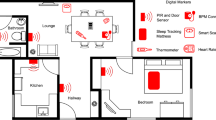Abstract
Health Remote Monitoring Systems (HRMS) offer the ability to address health-care human resource concerns. In developing nations, where pervasive mobile networks and device access are linking people like never before, HRMS are of special relevance. A fundamental aim of this research work is the realization of technological-based solution to triage and follow-up people living with dementias so as to reduce pressure on busy staff while doing this from home so as to avoid all unnecessary visits to hospital facilities, increasingly perceived as dangerous due to COVID-19 but also raising nosocomial infections, raising alerts for abnormal values. Sensing approaches are complemented by advanced predictive models based on Machine Learning (ML) and Artificial Intelligence (AI), thus being able to explore novel ways of demonstrating patient-centered predictive measures. Low-cost IoT devices composing a network of sensors and actuators aggregated to create a digital experience that will be used and exposure to people to simultaneously conduct several tests and obtain health data that can allow screening of early onset dementia and to aid in the follow-up of selected cases. The best ML for predicting AD was logistic regression with an accuracy of 86.9%. This application as demonstrated to be essential for caregivers once they can monitor multiple patients in real-time and actuate when abnormal values occur.
Access this chapter
Tax calculation will be finalised at checkout
Purchases are for personal use only
Similar content being viewed by others
References
Dementia: Sep. 2021. https://www.who.int/news-room/fact-sheets/detail/dementia. Accessed 26 Nov 2021
Boustani, M., Schubert, C., Sennour, Y.: The challenge of supporting care for dementia in primary care. Clin. Interv. Aging 2(4), 631–636 (2007)
2020 Alzheimer’s disease facts and figures. Alzheimers Dement. 16(3), 391–460 (2020). https://doi.org/10.1002/alz.12068
Alzheimer Europe – Alzheimer Europe – Our work – Annual Reports – Annual Report 2019. https://www.alzheimer-europe.org/Alzheimer-Europe/Our-work/Annual-Reports/Annual-Report-2019. Accessed 21 Jun 2021
Xia, X., Jiang, Q., McDermott, J., Han, J.-D.J.: Aging and Alzheimer’s disease: comparison and associations from molecular to system level. Aging Cell 17(5), e12802 (2018). https://doi.org/10.1111/acel.12802
Röcker, C., Ziefle, M., Holzinger, A.: From computer innovation to human integration: current trends and challenges for pervasive healthtechnologies. In: Holzinger, A., Ziefle, M., Röcker, C. (eds.) Pervasive Health. HIS, pp. 1–17. Springer, London (2014). https://doi.org/10.1007/978-1-4471-6413-5_1
Global Smart Healthcare Market Size Report, 2020–2027.” https://www.grandviewresearch.com/industry-analysis/smart-healthcare-market. Accessed 21 Jun 2021
Malasinghe, L.P., Ramzan, N., Dahal, K.: Remote patient monitoring: a comprehensive study. J. Ambient. Intell. Humaniz. Comput. 10(1), 57–76 (2017). https://doi.org/10.1007/s12652-017-0598-x
Haaksma, M.L., et al.: Comorbidity and progression of late onset Alzheimer’s disease: a systematic review. PLoS ONE 12(5), e0177044 (2017). https://doi.org/10.1371/journal.pone.0177044
Integrated care for older people: guidelines on community-level interventions to manage declines in intrinsic capacity. Geneva: World Health Organization, 2017. http://www.ncbi.nlm.nih.gov/books/NBK488250/. Accessed 21 June 2021
Moher, D., Liberati, A., Tetzlaff, J., Altman, D.G.: Preferred reporting items for systematic reviews and meta-analyses: the PRISMA statement. BMJ 339, b2535 (2009). https://doi.org/10.1136/bmj.b2535
Bott, N.T., et al.: Face-to-face and digital multidomain lifestyle interventions to enhance cognitive reserve and reduce risk of alzheimer’s disease and related dementias: a review of completed and prospective studies. Nutrients 11(9), 2258 (2019). https://doi.org/10.3390/nu11092258
Bird, M., et al.: The psychological determinants of making lifestyle and dietary behaviours after using an online cognitive health tool and its associated recommendations for protective cognitive health behaviours. Eur. J. Psychiatry 35(3), 145–156 (2021). https://doi.org/10.1016/j.ejpsy.2021.02.001
Aalbers, T., Baars, M.A.E., Qin, L., de Lange, A., Kessels, R.P.C., Olde Rikkert, M.G.M.: Using an ehealth intervention to stimulate health behavior for the prevention of cognitive decline in dutch adults: a study protocol for the brain aging monitor. JMIR Res. Protoc. 4(4), e130 (2015). https://doi.org/10.2196/resprot.4468
Wouters, H., et al.: Physical activity and cognitive function of long-distance walkers: studying four days marches participants. Rejuvenation Res. 20(5), 367–374 (2017). https://doi.org/10.1089/rej.2016.1876
Méndez-Sanz, R., de la Torre-Díez, I., López-Coronado, M.: What is your risk of contracting alzheimer’s disease? A telematics tool helps you to predict it. J. Med. Syst. 40(1), 1–8 (2015). https://doi.org/10.1007/s10916-015-0369-1
Saif, N., et al.: Feasibility of using a wearable biosensor device in patients at risk for alzheimer’s disease dementia. J. Prev. Alzheimer’s Dis. 7(2), 104–111 (2019). https://doi.org/10.14283/jpad.2019.39
Zampogna, A., et al.: Fifteen years of wireless sensors for balance assessment in neurological disorders. Sensors 20(11), 3247 (2020). https://doi.org/10.3390/s20113247
Higami, Y., Yamakawa, M., Shigenobu, K., Kamide, K., Makimoto, K.: High frequency of getting out of bed in patients with Alzheimer’s disease monitored by non-wearable actigraphy. Geriatr. Gerontol. Int. 19(2), 130–134 (2019). https://doi.org/10.1111/ggi.13565
Abbate, S., Avvenuti, M., Light, J.: MIMS: a minimally invasive monitoring sensor platform. IEEE Sens. J. 12(3), 677–684 (2012). https://doi.org/10.1109/JSEN.2011.2149515
Guarnieri, B., et al.: Multicenter study on sleep and circadian alterations as objective markers of mild cognitive impairment and alzheimer’s disease reveals sex differences. J. Alzheimers Dis. 78(4), 1707–1719 (2020). https://doi.org/10.3233/JAD-200632
Tchalla, A.E., et al.: Preventing and managing indoor falls with home-based technologies in mild and moderate Alzheimer’s disease patients: pilot study in a community dwelling. Dement. Geriatr. Cogn. Disord. 36(3–4), 251–261 (2013). https://doi.org/10.1159/000351863
Node-RED. https://nodered.org/. Accessed 26 Nov 2021
Author information
Authors and Affiliations
Corresponding author
Editor information
Editors and Affiliations
Rights and permissions
Copyright information
© 2022 The Author(s), under exclusive license to Springer Nature Switzerland AG
About this paper
Cite this paper
B. Elvas, L., Cale, D., Ferreira, J.C., Madureira, A. (2022). Remote Monitor System for Alzheimer Disease. In: Abraham, A., et al. Innovations in Bio-Inspired Computing and Applications. IBICA 2021. Lecture Notes in Networks and Systems, vol 419. Springer, Cham. https://doi.org/10.1007/978-3-030-96299-9_24
Download citation
DOI: https://doi.org/10.1007/978-3-030-96299-9_24
Published:
Publisher Name: Springer, Cham
Print ISBN: 978-3-030-96298-2
Online ISBN: 978-3-030-96299-9
eBook Packages: Intelligent Technologies and RoboticsIntelligent Technologies and Robotics (R0)




